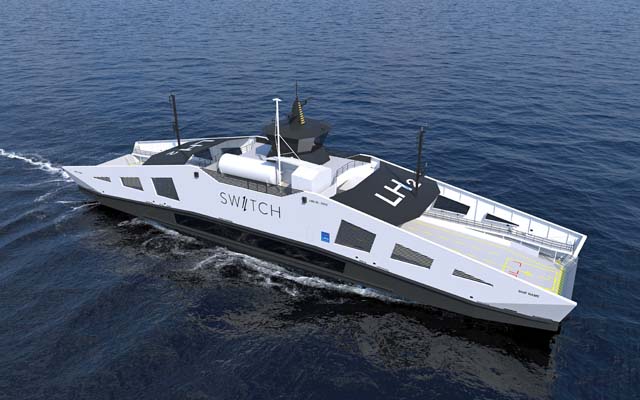US ship owning and leasing company Switch Maritime, which has previously launched the first hydrogen fuel cell powered ferry in the US, says it is pushing ahead with its next zero-emission vessel project.
In collaboration with LH2 Shipping and Norwegian ship designer LMG Marin, Switch plans to commence the US construction of an 80-car, 300-passenger ro-pax vehicle ferry (DNV-classed), similar to the LMG-designed ferry currently operating in Norway on liquid hydrogen (LH2) fuel.
Pace Ralli, Switch Founder and CEO, said: “Switch is proud to be at the forefront of the energy transition in US maritime shipping. With rigorous planning, state-of-the-art engineering, and support from leading industry partners and the US Coast Guard, we are ready to pioneer zero-carbon LH2 fuelling for heavier, higher-horsepower workboats.”
Switch’s first hydrogen-powered vessel, the Sea Change, is a 75-passenger catamaran ferry featuring 600kW electric motor propulsion, powered by 360kW of fuel cells with 246kg of gaseous H2 (GH2) storage at 250 bar pressure. The Sea Change successfully started public passenger service as part of the San Francisco Bay Ferry system in July 2024, after receiving its final Certificate of Inspection (COI) from the US Coast Guard in May 2024. It is currently fuelled once a week using a mobile compressed GH2 storage trailer towed behind a truck. Each fuelling takes about 2 hours to transfer 150kg, allowing for three consecutive days of passenger operation. When ferry service increases to seven days per week in the coming months, the Sea Change will be fuelled twice per week.
While Switch is supportive of all zero-emission vessel technologies, it has focused on hydrogen for its potential to serve as a viable option where other battery-only solutions fall short due to space and weight constraints. According to Switch, Generally, hydrogen as a fuel source is able to support greater range and power requirements due to its high energy density. Additionally, it simplifies zero-emissions vessel operations by eliminating the need for fixed shoreside charging infrastructure, allowing for fuelling through established truck-to-ship or ship-to-ship practices. Compressed GH2 is well suited for small- to medium-sized vessels; however, as vessel size and energy demand increases, cryogenic LH2 becomes the preferred storage solution. Similar to LNG, cryogenic LH2 supports faster refuelling speeds for large volumes (e.g. tons per hour).
In addition to the Sea Change, Switch is working on a 150-passenger, 25-knot catamaran to build for the SF Bay Ferry service, using the same gaseous H2 (GH2) storage and fuel cell equipment as the first vessel (to be revealed in Q1 2025). When designing larger zero-emissions harbour craft such as 300-plus passenger ferries, vehicle ferries and harbour tugs, Switch plans to transition from gaseous storage to cryogenic liquid H2.
Ralli said: “Our first H2 vessel was the result of years of close collaboration with the US Coast Guard, demonstrating the viability and safety of hydrogen fuelling. While the LH2 ro-pax ferry design is already DNVGL-classed, there is still some work to do to bring it into US Coast Guard compliance. What I like about LH2 fuelling is that it will follow the same IGF Code that applies to cryogenic LNG fuelling of ships in the US, so we have a precedent regulatory framework to work from.”
The larger steel hull of the vehicle ferry offers more flexibility in terms of space and weight compared to aluminium catamaran fast ferry designs, making it suitable for introducing LH2 fuelling in the US. The LH2 from the cryogenic storage tanks is vapourised onboard and used in the PEM fuel cells to create electricity for the electric motors. Like the GH2 fast ferries, the vessel’s only emissions will be pure water vapour, with zero carbon or other diesel-related emissions.
The ro-pax vehicle ferry will have a service speed of 14 knots, and is expected to require fuelling only once per week (volume of 3000kg from one LH2 truck) in a typical operation, with no requirement for shoreside electric charging infrastructure. Its Norwegian predecessor, the MF Hydra, is owned by Norled and performs a triangular six nautical mile round-trip vehicle ferry service, fuelling LH2 once every two weeks. The 4t LH2 tank (about the size of a 40ft container) fits easily on the top deck, and receives fuel from a LH2 truck via a bunkering system using over-pressure in the truck to push the liquid to the ship. To date, Hydra has successfully received LH2 fuel about 50 times since starting hydrogen-powered operation in March 2023, and notably, has not been out of service since operations started, other than for planned maintenance.
Image: SWITCH Maritime LH2 RoPax Ferry (credit: Business Wire)



